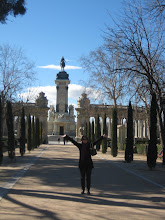Yesterday I went to my first Bullfight! Oh what an experience. When my mom was here she and I went to the bullfighting museum and got a little taste of what a bullfight was all about. I feel as though this prepared me a little bit for what was in store. I also had a general idea of how they are run. Some of my friends that I went with were not as familiar with what happens. They found out at the bullfight that yes, the bull is killed. We sat fairly close, probably 10 rows up and were definitely in the action! I was on the edge of my seat several times because the bull would just nearly catch the matador! Here is how it works:
(warning this might be a little gory!!)
Spanish-style bullfighting is called "corrida de toros" -literally "race of bulls". In a traditional corrida, three matadores("killers"), each fight two bulls and each goes twice to total six bulls. Each matador has six assistants — two picadores ("lancers") mounted on horseback, three banderilleros ("flagmen") - who known as toreros ("bullfighters")
Each fight is highly ritualized, with three distinct stages, the start of each is announced by a trumpet sound. The toreros enter the ring in a parade, called the paseíllo, accompanied by band music (all looking cute in their sparkly and colorful outfits, funny hats and black flats).
The bull enters the ring. This is the first stage, the tercio de varas("the lancing third"), and the matador first confronts the bull with the capote(cape), observing the behaviour of the bull while performing a tanda ("series of passes") to impress the crowd.
Next, a picador enters the arena on horseback armed with a vara ("lance"). To protect the horse from the bull's horns, the horse is surrounded by a peto — a protective mattress-like covering. At this point, the picador stabs just behind the neck, weakening the neck muscles. If the picador is successful, the bull will hold its head and horns lower during the following stages of the fight. This makes the bull's charges less dangerous, enabling the matador to perform.
In the next stage, the tercio de banderillas ("the third of flags"), the three banderilleros each attempt to plant two banderillas, sticks into the bull's shoulders.
In the final stage, the tercio de muerte ("the third of death"), the matador re-enters the ring alone with a small red cape, and a sword. The matador uses his cape to attract the bull in a series of passes which serve the dual purpose of wearing the animal down for kill and producing a beautiful display(Bulls are actually colorblind so they are not phased by the "red" of the cape! it's actually the movements). The stage ends with a final series of passes in which the matador with a muleta attempts to maneuver the bull into a position to stab it between the shoulder blades and through the heart.
If the matador did well, the crowd petitions the president to award the matador an ear of the bull by waving white handkerchiefs (we saw this happen twice!). If his performance was exceptional, he is award two, and sometimes a tail. After the performance the matador takes a "victory lap." During this lap, when the crowd often threw articles of clothing (handkercheifs, jackets) at the Matador to show their admiration.
It was tough to watch the first round even though I knew what to expect. The rounds after that I could watch a little better. I am glad that I went to the bullfight. It was definitely a cultural experience! Would I do it again? hmmm.....
Tuesday, April 13, 2010
Subscribe to:
Post Comments (Atom)

No comments:
Post a Comment